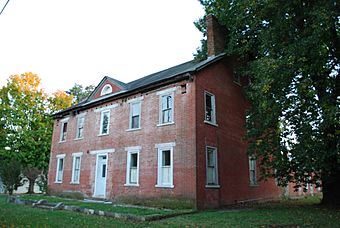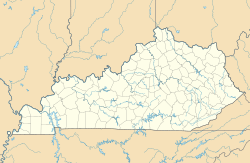Green River Female Academy facts for kids
Quick facts for kids |
|
|
Green River Female Academy
|
|
 |
|
| Location | 204 Goebel Avenue, Elkton, Kentucky |
|---|---|
| Built | 1835 |
| Architect | D. V. Robinson |
| Architectural style | Federal-Greek Revival Transitional |
| Added to NRHP | December 06, 1990 |
The Green River Female Academy is an important historical building in Todd County, Kentucky. It shows us how people thought about education for girls in the early 1800s in the United States. The building itself is also a great example of old Kentucky architecture, mixing styles like Georgian, Federal, and Greek Revival.
Contents
A Historic School Building
The Green River Female Academy was built for a group of people who wanted to create a school. Construction started in 1835 and finished in 1836. Many skilled workers, like masons and carpenters, helped build it.
Location and Size
This two-story building sits on a 1.5-acre piece of land in the city of Elkton. It has five sections across its front. The Green River Female Academy is the only school from before the Civil War in the wider Green River area that is still standing today.
Unique Architectural Style
David V. Robinson designed the building, and Jesse Russell and Daniel Grumbly built it. The academy mainly shows off the Federal and Greek Revival styles. However, it also has parts that remind us of the older Georgian style.
Design Details
The outside of the building mostly looks like the Federal style. This style often puts a lot of focus on the middle part of a building, making it stand out. You won't see a brick line around the building, which was common in the Georgian style. It also doesn't look like a Greek temple, which was a feature of the later Greek Revival period.
A special triangular shape above the central entrance, called a pedimented gable, is a clear sign of the Georgian period. The stone carvings above the windows and door have round decorations on the ends. These are typical of the Greek Revival style.
Inside the Academy
Inside, the building has a central hallway that goes through all three floors. The layout of the rooms is almost the same on every floor. It's thought that Robinson, Russell, and Grumbly might have used design books by Asher Benjamin and Owen Biddle Jr. to help them create the plans and details for the academy.
The Academy's Story
Money for building the academy came from selling shares, like buying a piece of a company. The school became very well-known in the 1800s. At that time, Kentucky, along with North Carolina, was known for having some of the best schools in the country.
A Principal Ahead of Her Time
During the early to mid-1800s, the school's principal, Lucinda Hannah Dickey, did something very unusual. She taught enslaved people to read and write. This was not accepted by society at that time.
Changes Over Time
The Green River Female Academy was only for girls until 1853, when it started letting young men attend too. Many students who graduated from the academy went on to study at famous colleges like Yale and Columbia.
Important people, such as United States Supreme Court Justice James Clark McReynolds, also attended the school. He did very well in his studies under Major Samuel Robert Crumbaugh, who was a graduate of the United States Naval Academy.
Decline and New Purpose
The school kept its good reputation until the late 1880s. Around that time, Elkton became a center for education with many new colleges and schools opening. Because of these new options, fewer students attended the Green River Academy.
After the academy closed, its shares were mostly sold to the City of Elkton. The building was then used as a public school for the community. It continued as a school until the shares were no longer active. After that, Judge Walton Forgy bought the building and turned it into his home.
Restoring a Piece of History
Today, the Green River Academy Preservation Society takes care of the building. In the spring of 2011, Governor Steve Beshear gave the society a grant of $500,000. This money was used to help restore the historic building.


